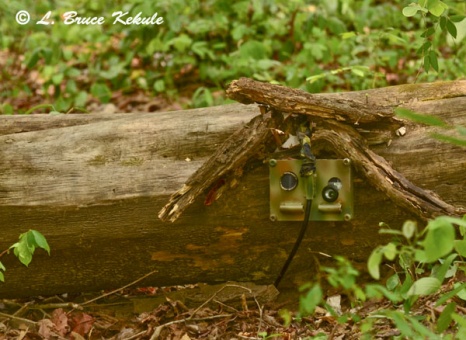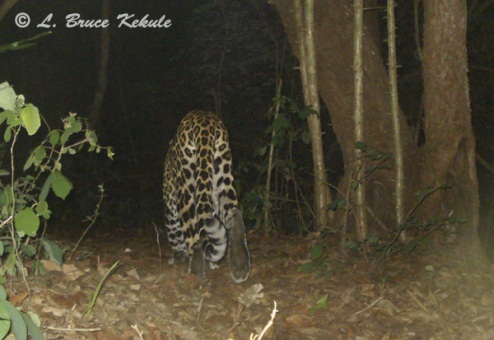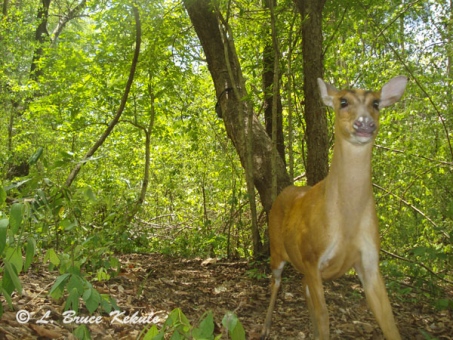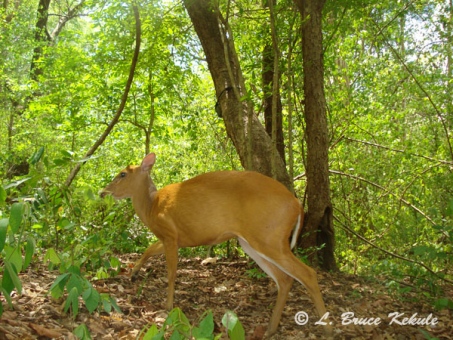Huai Kha Khaeng ongoing camera trap saga
New camera trap gets a leopard and tiger first time out
Sony W55 in Otter 2000 case with a Snapshotsniper SSII board and 3 AA externals
The feeling of accomplishment is the best part of building a ‘homebrew’ trail camera and then sharing the photos with others. I am extremely lucky to be working in a place that is one of the top tiger reserves in the world, and is extremely productive for camera trapping. It is not only the tigers, but also other predators like leopard, wild dog and jackal, and their prey species such as deer, pig and wild cattle that makes Huai Kha Khaeng Wildlife Sanctuary truly special.
A leopard caught by the Sony W55 camera trap
When I first built this unit, I had one fallen tree across a trail in mind and it proved to be the right choice. I designed the cam to slip the 10mm ‘Python’ locking cable around the horizontal log. One of the first animals to jump over was a mature male leopard several nights after the setup. This frame filling shot is what I was hoping for.
Leopard caught again as it went down the trail
Several nights later, a tiger went over and the W55 caught its rear end as it disappeared down the trail. A female muntjac (barking deer) was also caught. This was after only a 15-day soak and shows the tremendous biodiversity of this amazing place. This unit definitely worked as designed: to scout a game trail with a low-down set-up.
Tiger caught going down game trail several nights later
The next order of business now is to build a Nikon ML-3 ‘active-infrared’ controlled SLR Nikon F5 film camera using Fuji Provia 400 ISO slide film, and a Nikon D2x DSLR and both can fire five shots a second in ‘continuous mode’ with several wireless SB600s or SB28s. These two cameras are my old prime camera bodies that I have kept over the years (they were really expensive), and I have resurrected them for this project. The Nikon D2x is now in the Nikon shop for an overhaul but will be finished real soon.
Female muntjac (barking deer) caught by the camera trap
My main objective is to catch the cats making the jump. I will eventually be installing both units close together on either side of this log about a meter or so away from the trail. The sensors need to be slightly angled away so as to activate them a bit early. Both cameras will be using an 18-35mm wide-angle lens (the zoom setting of the lens will be adjusted when installed) and that should help to catch these quick-acting animals. The units have to be precise and fast, and fire off a good string of shots with several flashes.
Muntjac spooked by the camera’s flash
The only negative aspect with active infrared at night; the first shot will not trip the flash but follow up shots will be OK. But I can also hard wire a flash for each cam with a sync-cable in conjunction with the wireless flashes and that should be enough. I will also experiment with a ‘passive infrared’ system that can wake-up the flashes in time for the shot. However, this is a hit and miss situation whereas active infrared is usually spot on and will trip immediately after the beam is broken.
The system will be modular so sensors and camera are separate, and they will be ‘plug and play’ units. That’s the plan anyway for this absolutely amazing wildlife game trail. I have all the parts ready; just finding time to put it all together is the next trick.
Got a very busy schedule with a trip to Africa and the States for the next couple of months. But I will be getting the SLR and DSLR camera traps up and running shortly after getting back to Thailand, and of course will post the builds. Most important: they have to be ‘elephant proof’ but I have that covered as usual.
Posted from Tsavo National Park, southern Kenya, Africa







